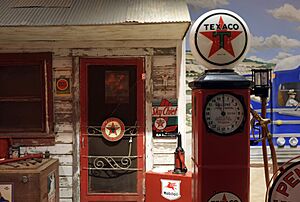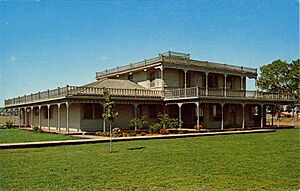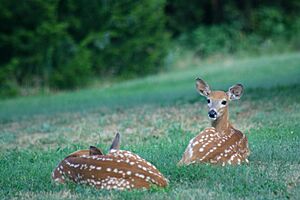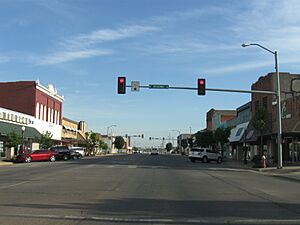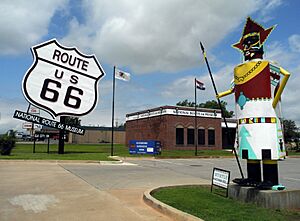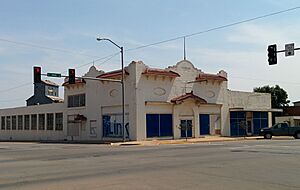Elk City, Oklahoma facts for kids
Quick facts for kids
Elk City, Oklahoma
|
|
|---|---|
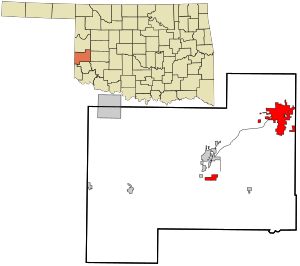
Location in Beckham County and Oklahoma
|
|
| Country | United States |
| State | Oklahoma |
| County | Beckham |
| Founded | 1901 |
| Area | |
| • Total | 16.15 sq mi (41.84 km2) |
| • Land | 15.93 sq mi (41.26 km2) |
| • Water | 0.22 sq mi (0.58 km2) |
| Elevation | 1,936 ft (590 m) |
| Population
(2020)
|
|
| • Total | 11,561 |
| • Density | 725.78/sq mi (280.22/km2) |
| Time zone | UTC-6 (Central (CST)) |
| • Summer (DST) | UTC-5 (CDT) |
| ZIP codes |
73644, 73648
|
| Area code(s) | 580 |
| FIPS code | 40-23500 |
| GNIS feature ID | 2410424 |
Elk City is a city in Beckham County, Oklahoma, United States. In 2020, about 11,561 people lived there. This was a small drop from the 11,693 people counted in 2010.
Elk City is located in western Oklahoma. It sits right on Interstate 40 and Historic U.S. Route 66. It's about 110 miles (177 km) west of Oklahoma City and 150 miles (241 km) east of Amarillo, Texas.
Contents
History of Elk City
Early European Exploration
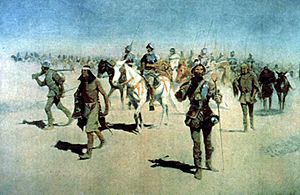
In 1541, Francisco Vásquez de Coronado was likely the first European to travel through this area. He was a Spanish conquistador, which means a Spanish explorer and conqueror. Coronado was heading northeast across the plains. He was looking for a city called Quivira, which was rumored to be full of gold. It's possible his journey took him right through or very close to where Elk City is today.
From Founding to Statehood
Elk City's story began right after the Cheyenne-Arapaho reservation opened. This happened in western Oklahoma Territory on April 19, 1892. That's when the first white settlers arrived. Before this, many ranchers used to drive cattle from Texas to Dodge City, Kansas. This famous route, called the Great Western Cattle Trail, passed right through the future site of Elk City.
The idea for Elk City came from land promoters in Weatherford, Oklahoma. They found out that the Choctaw, Oklahoma and Gulf Railroad (CO & G) was building tracks towards the area. This was around 1898. These smart businessmen saw that the area near the source of Elk Creek would be a great spot for a town. So, they bought land from the homesteaders who had claims along the railroad line.
March 20, 1901, was a very important day for Elk City. This was when the Choctaw Townsite and Development Company first sold lots of land. Hundreds of people who wanted to buy land had already set up a "tent city." On that day, the company sold $32,000 worth of property. That's like selling over $870,000 worth of property in today's money!
There's a bit of a mystery about how Elk City got its name. It was named after Elk Creek. This creek was named by U.S. Army Captain Randolph B. Marcy in 1852. He was exploring the Red River. Marcy saw elk tracks near the stream and decided to call it "Elk Creek." He noted that elk used to be common in the Wichita Mountains but were rarely seen by then.
For a while, the town had different post office names, like Crowe and Busch. So, on some old maps of Oklahoma Territory, you might see "Crowe" or "Busch" instead of "Elk City." Finally, on July 20, 1907, just before Oklahoma became a state, the Busch Post Office officially changed its name to Elk City Post Office.
On August 13, 1901, the railroad tracks reached Elk City. This brought easy train access to the town. Regular train service started a week later, on August 20. People in the city were very happy. They believed that the simple dugouts and shacks would soon be replaced by nice homes and big barns.
By January 1902, Elk City had over sixty businesses and more than 1,000 people. They even started paving the streets with bricks that year. Even though it was less than a year old, Elk City was already one of the biggest towns in western Oklahoma. The town kept growing, even after two big fires in 1903 and 1906 that destroyed many businesses. By the time Oklahoma became a state in 1907, the population had grown to 3,000 people. This prairie community had become a true "boomtown."
Geography and Climate
Elk City is located in the northeastern part of Beckham County.
The city covers a total area of about 16.4 square miles (42.5 km²). Most of this, about 16.2 square miles (41.9 km²), is land. Only a small part, about 0.2 square miles (0.6 km²), is water.
Climate of Elk City
Elk City has a humid subtropical climate. This means it has hot, humid summers and mild winters. The hottest temperature ever recorded in Elk City was 114°F (46°C) on July 19, 2022. The coldest temperature recorded was -12°F (-24°C), which happened on January 17, 1930, and again on January 19, 1984.
| Climate data for Elk City, Oklahoma, 1991–2020 normals, extremes 1904–present | |||||||||||||
|---|---|---|---|---|---|---|---|---|---|---|---|---|---|
| Month | Jan | Feb | Mar | Apr | May | Jun | Jul | Aug | Sep | Oct | Nov | Dec | Year |
| Record high °F (°C) | 84 (29) |
95 (35) |
98 (37) |
100 (38) |
106 (41) |
111 (44) |
114 (46) |
113 (45) |
108 (42) |
103 (39) |
90 (32) |
88 (31) |
114 (46) |
| Mean maximum °F (°C) | 73.0 (22.8) |
78.2 (25.7) |
85.4 (29.7) |
88.8 (31.6) |
94.2 (34.6) |
97.7 (36.5) |
103.1 (39.5) |
101.9 (38.8) |
96.2 (35.7) |
90.7 (32.6) |
80.3 (26.8) |
72.0 (22.2) |
103.9 (39.9) |
| Mean daily maximum °F (°C) | 50.4 (10.2) |
54.5 (12.5) |
63.9 (17.7) |
72.3 (22.4) |
80.5 (26.9) |
89.2 (31.8) |
94.7 (34.8) |
93.6 (34.2) |
85.4 (29.7) |
74.0 (23.3) |
61.4 (16.3) |
51.2 (10.7) |
72.6 (22.5) |
| Daily mean °F (°C) | 38.2 (3.4) |
41.8 (5.4) |
50.6 (10.3) |
59.0 (15.0) |
68.4 (20.2) |
77.3 (25.2) |
82.1 (27.8) |
80.9 (27.2) |
73.0 (22.8) |
61.0 (16.1) |
49.1 (9.5) |
39.8 (4.3) |
60.1 (15.6) |
| Mean daily minimum °F (°C) | 26.1 (−3.3) |
29.0 (−1.7) |
37.4 (3.0) |
45.6 (7.6) |
56.3 (13.5) |
65.3 (18.5) |
69.6 (20.9) |
68.3 (20.2) |
60.7 (15.9) |
48.1 (8.9) |
36.8 (2.7) |
28.5 (−1.9) |
47.6 (8.7) |
| Mean minimum °F (°C) | 11.0 (−11.7) |
14.6 (−9.7) |
19.9 (−6.7) |
31.0 (−0.6) |
42.0 (5.6) |
54.5 (12.5) |
61.2 (16.2) |
59.6 (15.3) |
46.7 (8.2) |
31.4 (−0.3) |
19.7 (−6.8) |
13.3 (−10.4) |
7.2 (−13.8) |
| Record low °F (°C) | −12 (−24) |
−8 (−22) |
−3 (−19) |
19 (−7) |
31 (−1) |
42 (6) |
50 (10) |
45 (7) |
28 (−2) |
17 (−8) |
9 (−13) |
−9 (−23) |
−12 (−24) |
| Average precipitation inches (mm) | 0.88 (22) |
1.00 (25) |
2.10 (53) |
2.74 (70) |
4.45 (113) |
3.77 (96) |
2.48 (63) |
3.70 (94) |
2.80 (71) |
2.90 (74) |
1.42 (36) |
1.28 (33) |
29.52 (750) |
| Average snowfall inches (cm) | 2.7 (6.9) |
2.2 (5.6) |
0.7 (1.8) |
0.0 (0.0) |
0.0 (0.0) |
0.0 (0.0) |
0.0 (0.0) |
0.0 (0.0) |
0.0 (0.0) |
0.1 (0.25) |
0.5 (1.3) |
2.4 (6.1) |
8.6 (21.95) |
| Average extreme snow depth inches (cm) | 2.1 (5.3) |
0.9 (2.3) |
0.7 (1.8) |
0.0 (0.0) |
0.0 (0.0) |
0.0 (0.0) |
0.0 (0.0) |
0.0 (0.0) |
0.0 (0.0) |
0.0 (0.0) |
0.6 (1.5) |
2.3 (5.8) |
3.2 (8.1) |
| Average precipitation days (≥ 0.01 in) | 4.3 | 3.9 | 6.2 | 6.3 | 8.7 | 8.7 | 5.9 | 7.6 | 6.6 | 6.7 | 5.0 | 4.7 | 74.6 |
| Average snowy days (≥ 0.1 in) | 1.5 | 1.2 | 0.5 | 0.1 | 0.0 | 0.0 | 0.0 | 0.0 | 0.0 | 0.1 | 0.2 | 1.7 | 5.3 |
| Source 1: NOAA | |||||||||||||
| Source 2: National Weather Service | |||||||||||||
People of Elk City (Demographics)
| Historical population | |||
|---|---|---|---|
| Census | Pop. | %± | |
| 1910 | 3,165 | — | |
| 1920 | 2,814 | −11.1% | |
| 1930 | 5,666 | 101.4% | |
| 1940 | 5,029 | −11.2% | |
| 1950 | 7,963 | 58.3% | |
| 1960 | 8,196 | 2.9% | |
| 1970 | 7,323 | −10.7% | |
| 1980 | 9,569 | 30.7% | |
| 1990 | 10,428 | 9.0% | |
| 2000 | 10,510 | 0.8% | |
| 2010 | 11,693 | 11.3% | |
| 2020 | 11,561 | −1.1% | |
| U.S. Decennial Census | |||
In 2010, there were 11,693 people living in Elk City. The city had about 719 people per square mile (278 people per km²). There were 4,973 homes.
Most people in Elk City were White (88.95%). Other groups included African American (3.06%), Native American (3.02%), and Asian (0.54%). About 5.96% of the population was Hispanic or Latino.
Out of all households, 34.4% had children under 18 living with them. About 51.4% were married couples living together. The average household had 2.47 people, and the average family had 3.02 people.
The median age in the city was 36 years old. About 27.2% of the population was under 18.
Economy and Jobs
Elk City is a main trading center for Western Oklahoma and parts of the Texas Panhandle. It serves over 50,000 people in a 60-mile (97 km) area. Many things help Elk City's economy, including oil, farming, wind energy, transportation, tourism, manufacturing, and healthcare.
Since 2000, Elk City has seen a nearly 3% increase in jobs. Experts expect the number of jobs to grow by about 42% in the next ten years!
Elk City is in an area rich with oil and natural-gas. Because of this, the oil industry is very important to the city's economy. Elk City even calls itself the "Natural Gas Capital of the World." You can see Parker Drilling Rig #114 downtown. This rig is 180 feet (55 m) tall and is the world's tallest non-working oil rig. Elk City has grown a lot because many oil field service and drilling companies have opened there.
Farming is not as big as it used to be, but Elk City is still a key place for farmers and ranchers to buy and sell goods, especially at the livestock auction.
In 2009, the first local wind farm, the Red Hills Wind Farm, started working. It's about 8 miles (13 km) north of Elk City. This wind farm has 82 wind turbines. They produce enough clean energy to power over 40,000 homes!
Transportation has always been important to Elk City's economy. The famous U.S. Route 66 was built right through the city in the 1930s. Today, Interstate 40 serves the city. About 60,000 travelers pass through Elk City every day. This highway connects Elk City to Oklahoma City in the east and Amarillo, Texas, in the west. The city also has the Elk City Regional Business Airport.
Since Historic U.S. Route 66 runs through Elk City, a large museum complex has grown there. It includes:
- the National Route 66 Museum
- the Old Town Museum
- the Transportation Museum
- the Farm and Ranch Museum
- the Blacksmith Museum
Each museum is in its own building. Together, they look like an early Elk City town, with old general stores, a bank, a train station, and other buildings. Elk City is also close to other fun places in Western Oklahoma. These include Foss State Park, the Washita National Wildlife Refuge, and the Washita Battlefield National Historic Site.
Bar-S Foods Company has a warehouse in Elk City where they store and send out packaged meats.
Great Plains Regional Medical Center is the biggest employer in Elk City. It helps people in Western Oklahoma and the eastern Texas Panhandle. The hospital has been named one of the "Thirty Best Places to Work in Oklahoma" several times. A new, large hospital building opened in July 2009.
In 2009, it was announced that a Walmart Supercenter would be built. This brought at least 150 new jobs to the city. It opened in October 2010 and is the largest store between Amarillo and Oklahoma City.
Education
Elk City has three school districts:
- Elk City Public Schools Elk City Public Schools
- Merritt Public Schools Merritt Public School
- Sayre Public Schools
Elk City Public Schools and Merritt Public Schools are part of the Western Technology Center District. WTC offers special training for adults and high school students. High school juniors and seniors in these districts can attend WTC classes for free. This helps them learn skills for different jobs.
Media
Newspaper
- Elk City Daily News
Radio
- KECO 96.5 FM (Country music)
- KKZU 95.5 FM (Classic Rock music)
- KOOL 94.3 FM (Classic Hits music)
- KADS 1240 AM (Sports Talk)
Transportation
- Bus service: Greyhound Lines provides bus service.
- Airport: The Elk City Regional Business Airport (KELK) is 1 mile (1.6 km) northeast of the city. It has a paved runway.
- Commercial flights: You can find commercial flights at Will Rogers World Airport (about 112 miles east) or Rick Husband Amarillo International Airport (about 140 miles west).
- Rail freight: Farmrail Corporation provides rail service for cargo.
Attractions
Historic Places
Several buildings in Elk City are listed on the National Register of Historic Places:
- Casa Grande Hotel
- Hedlund Motor Company Building
- Storm House
- Whited Grist Mill
Route 66 Stops
- National Route 66 Museum Complex
Museums
Elk City has five museums to explore:
- the Old Town Museum
- the National Route 66 Museum
- the National Transportation Museum
- the Farm and Ranch Museum
- the Blacksmith Museum
Notable People
Many interesting people have come from Elk City:
- Cade Davis, a European basketball player
- Keitha Dickerson, a basketball player for Texas Tech and the WNBA
- Richard Hart, a jazz guitarist
- Justin McBride, a world champion bull rider
- Scott Meacham, who was the State Treasurer of Oklahoma
- Kelli O'Hara, an award-winning Broadway actress and singer
- Susan Powell, Miss America 1981, actress, and singer
- Joe Spencer, an NFL football player
- Jimmy Webb, a Grammy Award-winning songwriter
See also
 In Spanish: Elk City (Oklahoma) para niños
In Spanish: Elk City (Oklahoma) para niños


